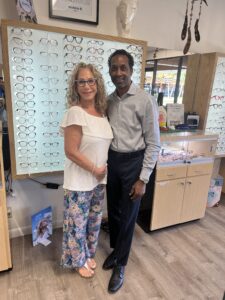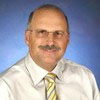
Sandy and Michael, opticians at Seacrest Optical in Delray Beach, Fla. Dr. Snyder passed along to them the approach he took in his own practice for reducing remakes from outside eyeglass prescriptions.
A simple approach to avoiding remakes when the prescription comes from another office.
By Ronald P. Snyder, OD, FAAO
August 23, 2023
The idea for this article stems from a recent conversation I had with the owner of an optical shop. She told me that a local eye doctor, in addition to billing Medicare, charged his patients $120 for a refraction–a refraction which, despite the high cost, was not reliable.
These patients were then coming to her store to have the prescription filled, but many were not adapting well to the new prescription, which resulted in many remakes.
She believes that the source of the problem was that the refractions were being performed by technicians, and were not always accurate. Since she was the one who ultimately filled these prescriptions from the outside, the significant number of remakes were costing her money, and often resulted in upset and sometimes irate customers.
Do you fill eyeglass prescriptions from outside sources? If your answer to this question is no, then you do not need to finish reading this article.
Filling an outside prescription can be profitable to your bottom line. However, doing so can also result in unhappy customers and remakes that will negatively affect your bottom line.
In my practice, it was our policy to fill prescriptions from outside sources. However, I can assure you that we were able to successfully avoid these pitfalls and remakes. Here are the four steps of our protocol when a patient came to us with an outside eyeglass prescription to fill:
Step 1: We would first ask the customer if we could “neutralize” their current eyeglasses to compare it to the new prescription.
Step 2: We would then say something like this to the customer, “There appears to be a minor discrepancy between your old prescription and the new prescription.” We would then say, “Before we fill your new prescription, would it be OK with you if the doctor did a prescription verification at no charge?” Most customers were delighted to accept our offer and were impressed that we went out of our way to ensure they received the correct prescription.
Other Articles to Explore
Step 3: The customer was then escorted into the screening room where an auto-refraction was performed by a technician.
Step 4: The technician would then introduce the customer to the doctor, who performed a refraction via an electronic phoropter.
This process required no more than five minutes of the doctor’s time, but most importantly, it established a rapport with the doctor.
The purpose of this approach was two-fold: 1) to introduce the customer to the doctor; and 2) to recheck the customer’s prescription for accuracy to avoid a future remake. You might be surprised that our rechecks often indicated that the outside prescription needed modification.
Most customers would say, “My other doctor did not have your technology.” They truly appreciated the extra care we provided. Many of these customers returned as patients, and referred family and friends.

Ronald P. Snyder, OD, FAAO, is the president and CEO of HealthCare Registries, LLC. To contact him: RonSnyder@HealthCareRegistries.com

























